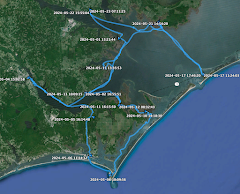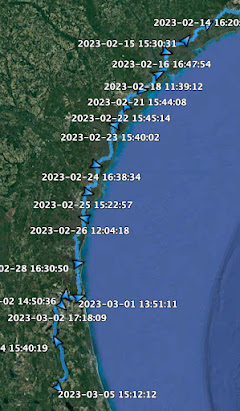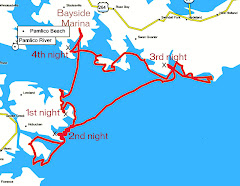It was up the eastern branch of the Elizabeth River today, a place I seldom visit, for a trip with some science-type friends from NOAA. It was a crew out of Annapolis that was in search of potential sites for oyster reef restoration or building.
So why find a fished out oyster reef and restore it? Or why haul in a pile of old oyster shells and build a new reef from scratch? Lots of reasons. Oysters filter water, removing contaminants, which allows for sub-aquatic vegetation to grow, which reduces the chance for erosion and provides a habitat for juvenile forms of fish, shrimp and crabs. Oysters are food (but I wouldn't eat these - we'll get to that later), and provide an ecosystem for all those fish, shrimp, crabs that are food for bigger marine animals, which themselves become food for even larger forms of marine life. Follow that food chain a few links and you will find people like me who love to eat seafood. Clean the water, prevent erosion, create nurseries for seafood - seems worthwhile to me.
The boat had four types of sonar on board including single beam, multi beam, side scan and sub-bottom profiler. It was the side scan sonar that produced the image below showing both a sunken ship (pretty cool don't you think) and the dark area, particularly the place marked with a tiny red dot, that might be the perfect area for an oyster reef.
Beyond the sonar scans, they were also doing "ground truthing" by dropping a ponar (nobody could explain the source of the word) over the side and bringing up bottom samples. Sometimes it was mud or silt - not good for oysters - sand, old oyster shells - great for oysters - and, as you can see below, some live oysters. They brought in several live oysters today, indicating that the river was a healthy place for the shellfish. But just because it is a good place for oysters to grow, it doesn't mean that these oysters are good for us to eat. As filter feeders living in one of the oldest industrial rivers in the country, they are full of toxins. It will be years of work, maybe decades, before any edible oysters come out of this river. But healthy oyster reefs are at least a start.
It was a great day on the water, a learning experience and a lot of fun. Thanks, guys, for having me along.












































2 comments:
Hey Steve, love your blog. The Eastern Branch is my river. We live on the Southern bank opposite the Broad Creek bridge. We used to keep our sailboat behind the house but it was such a pain to get through all the bridges and out to open water that we finally gave up and took a slip at Salt Ponds in Hampton. I'll probably never live long enough to see this river cleaned up, but I hope my kids will. The sunsets are still beautiful, even if the water is less than pristine.
Chris
I had noticed your catamaran had moved. I understand why with the bridges - we got hung up for a while each way. But it was a pretty river, and a nice day to be on the water.
steve
Post a Comment